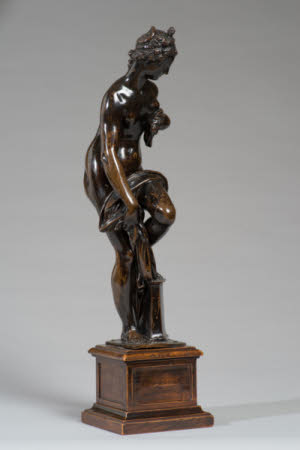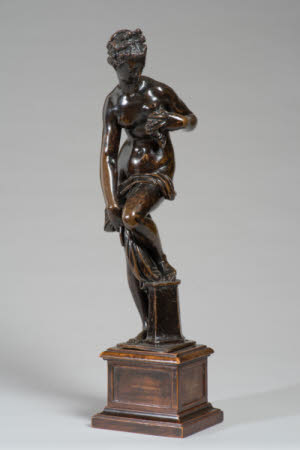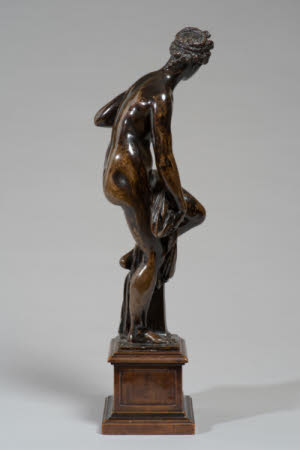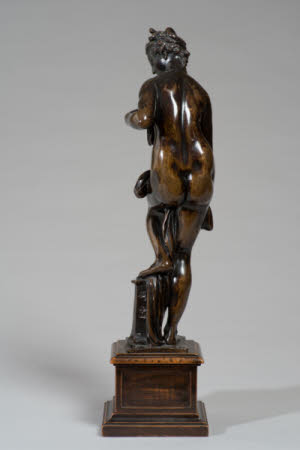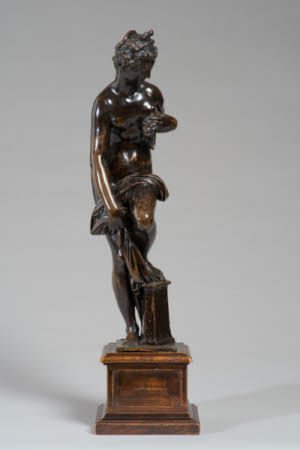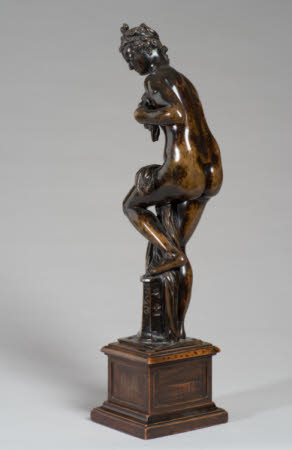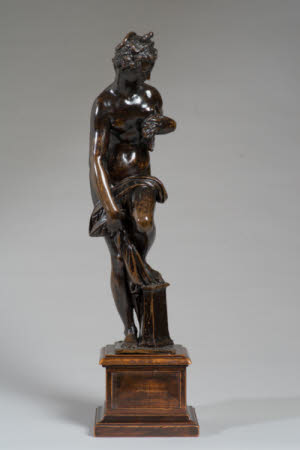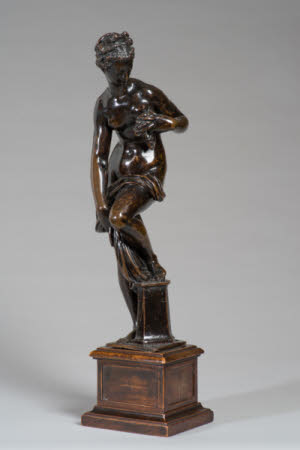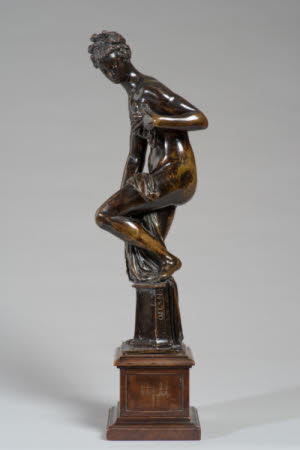Woman after the bath (‘The Cesarini Venus’)
after Giambologna (Douai 1529 - Florence 1608)
Category
Art / Sculpture
Date
circa 1583 (model) - 1620 - 1670 (cast)
Materials
Bronze on wooden socle
Measurements
333 mm (Height)
Place of origin
Florence
Order this imageCollection
Anglesey Abbey, Cambridgeshire
NT 515035
Summary
Bronze on wooden socle, A woman after the bath (‘The Cesarini Venus’), Florentine, after a model by Giambologna (1529-1608), model c.1583; probably cast c.1620-70. A bronze statuette of a naked woman, depicted as if she has emerged from the bath and is drying herself. She stands, her hair elaborately arranged, head turned to her left, with an abstracted, self-absorbed gaze. Her left leg is raised and her foot rests on a hexagonal pedestal; a swathe of drapery winding around her upper legs and falling between her knees, whilst she dries her left breast with a small towel. Cast with small rectangular base plate, with holes drilled at each corner for screws that attach the sculpture to its wooden socle. Screw at front left missing. Circular plug in woman’s right foot. Incised into side of base directly below woman’s left foot is the number, ‘No. 210’. On the adjacent side at back, another incised number has been gouged out, but almost certainly once read ‘48’. Brown lacquer patination; below it, some traces of a golden surface. Head of woman was separately cast, the joint now visible.
Full description
The Woman after the Bath was one of the most characteristic and successful models of the Italo-Flemish sculptor Jean Boulogne, better known by his Italian names of Giovanni Bologna, or Giambologna. After around a decade living and working in Rome, Giambologna arrived in Florence in the early 1560s, where he spent the remainder of his life, building a highly successful career as the court sculptor to the Medici Grand Dukes. Giambologna worked in marble, bronze and other media, his sculpture ranging from colossal marble groups to highly-finished small bronzes. He brought a new vitality to Florentine sculpture, his work exerting enormous influence both in Italy and beyond. This was in part owing to his innovative development of figure sculpture, in particular the creation of complex figure groups spiralling around a central axis, such as Samson and the Philistine in the Victoria & Albert Museum. Giambologna was the first artist to produce high quality bronze reproductions of his models, bronze figures produced in his workshops becoming sought after diplomatic gifts. A large group was presented by Duke Cosimo II de'Medici to Henry Prince of Wales, son of James I, in 1612. Long after Giambologna’s death his Florentine workshop continued to be operated by his successors, among them Pietro Tacca (1577-1640) and his son Ferdinando (1619-1686), and to continue to cast bronzes after the original models of the master. The Woman after the Bath is a classic example of the figura serpentinata motif, the key work in the sequence of depictions of a naked bathing woman, which preoccupied Giambologna throughout his career. The dating of the model continues to be a matter of lively debate, oscillating between the 1560s and the early 1580s, when Giambologna and his workshop carved for Giangiorgio Cesarini a large marble version, known as the Cesarini Venus, today in Palazzo Margherita, the United States Embassy in Rome. The relationship between the marble and the numerous small bronze versions of this model, notably a very fine signed version in the Kunsthistorisches Museum, Vienna, has been the subject of much discussion. The main scholarly argument has revolved around the question of whether the small bronze model was conceived before the marble, perhaps as early as the 1560s, or whether small bronzes only began to be made from the 1580s, to meet a demand for small versions of the Cesarini Venus. A recently discovered letter concerning the sending in 1586 of a small bronze version to the Emperor Rudolf II may well refer to the signed bronze today in Vienna, which would mean that the small bronzes are more likely to have started to be made from the 1580s, after the completion of the marble. A large number of small bronze replicas of the model survive, which vary in their size and in some of the details. Their quality varies significantly, suggesting that this attractive model continued to be reproduced for a long time, into the nineteenth century. One early example was among the large group of bronzes sent to London in 1612, as a gift to Prince Henry; it is presumably identifiable with the version of the model recorded in Charles I’s collections at Whitehall in 1639, as ‘a stoopeing standing woeman upon one legg with her right hand covering her left breast and with her left hand houlding a drapery to hide her nakedenes, being upon a black wooden peddistall./0 f 10 – 0 f 0’ (Oliver Millar, ed., ‘Abraham van der Doort’s Catalogue of the Collections of Charles I’, The Walpole Society, 37 (1960), p. 94, no. 16). No longer in the Royal Collection, it was no doubt sold off in the Commonwealth sales of the royal collections, held after the execution in 1649 of King Charles I. The example at Anglesey Abbey is one of a small number of versions of the model that are mounted on a rectangular base plate. Well modelled and finished, it has usually been attributed to Antonio Susini (active 1580, died 1624), who was for many years one of Giambologna’s principal assistants, before setting up his own workshop in 1600. Susini was celebrated for his skills as a caster and finisher of bronzes, Giambologna accordingly delegating to him much of the work of casting and finishing his bronzes. Although of respectable quality, the Anglesey Abbey bronze does not match the quality of the best casts by Antonio Susini, but is nevertheless certainly the product of a Florentine workshop, and perhaps datable to the early seventeenth century. Like other seventeenth-century rulers, King Louis XIV of France (1643-1715) was keen to acquire bronze casts of models by Giambologna for his collection. The number ‘210’ inscribed onto the rear of the hexagonal pedestal is an inventory number, which tells us that the Anglesey Abbey Venus once belonged to the collections of Louis XIV. Almost all the bronzes in the French royal collections were marked with these distinctive incised numbers, which can be related to inventories that were periodically taken, from the first one in 1684, until the French Revolution. No. 210 was first recorded in an inventory made in 1707. However, Louis in fact owned two versions of the Cesarini Venus, nos. 48 and 210 in the inventories. What would appear to be the figure with the no.48 was recently on the art market. Confusingly, there are today three versions of the model that survive with the same incised inventory number, ‘210’ - the Anglesey Abbey bronze and two others in the Menil Foundation collection, Houston and the Musée du Louvre, Paris (Giambologna 1529–1608: Sculptor to the Medici, nos. 3-4). The incised number on the modest version in the Menil Collection has certainly been added at a later date, in all probability very recently, even the second half of the twentieth century. It would seem likely that the number on the Louvre version, only certainly documented from the second half of the last century, is also a later addition. The Anglesey Abbey version on the other hand has two numbers, the first almost completely gouged away, although enough traces survive to allow the number ‘48’ to be read. Assuming that the version recently on the art market is identical with the one marked with the number 48, which was listed among those delivered to the merchant Jacques Chapeaurouge (Pierre Verlet, ‘Chapeaurouge et les collections royales françaises’ in ed. Werner Gramberg, Festschrift für Erich Meyer zum sechzigsten Geburtstag 29. Oktober 1957. Studien zu Werken in den Sammlungen des Museums für Kunst und Gewerbe Hamburg, Hamburg 1959, pp. 286-94, p. 289), then the Anglesey Abbey Venus cannot ever have been no. 48. It seems probable therefore that this number was applied in error by those making the inventory of the king’s bronzes in 1707 and that, once the error was discovered, it was deleted and replaced by no. 210. Consequently, the National Trust version must logically be no. 210, although without assembling side-by-side the different versions bearing this number, this must remain to some extent hypothetical. To confound the confusion, the inventory number 210 was also applied to a completely different bronze figure of Hercules in the Royal Collection, now in the Musée du Louvre (Bronzes de la Couronne, no. 210 (1)). Jeremy Warren 2019
Provenance
Ordered for the French Royal Collection from Italy; arrival recorded in Garde-Meuble on 12 September 1669, thence in the French Royal Collection until 1796; ceded to the merchant Jacques Chapeaurouge (1744-1805) in 1796, with other bronzes from the former Royal Collections; acquired at an unknown date, probably after 1940, by Urban Huttleston Rogers Broughton, 1st Lord Fairhaven (1896-1966); bequeathed to the National Trust by Lord Fairhaven with the house and the rest of the contents.
Credit line
The National Trust, Fairhaven Collection, Anglesey Abbey
Marks and inscriptions
Back of socle: '210’ and [gouged away] ‘48’
Makers and roles
after Giambologna (Douai 1529 - Florence 1608), sculptor
Exhibition history
The Lost Prince: The Life and Death of Henry Stuart, , National Portrait Gallery, London, 2012 - 2013, no.52
References
Christie, Manson & Woods 1971: The National Trust, Anglesey Abbey, Cambridge. Inventory: Furniture, Textiles, Porcelain, Bronzes, Sculpture and Garden Ornaments’, 1971, p. 138, Silver Strong Room Avery and Radcliffe 1978: Charles Avery and Anthony Radcliffe, Giambologna, 1529-1608: sculptor to the Medici, exh.cat. venues: Royal Scottish Museum, Edinburgh, Victoria & Albert Museum, London, Kunsthistorisches Museum, Vienna 1978, p. 63, no. 2 Avery, Radcliffe and Leither-Jasper 1978: Charles Avery, Anthony Radcliffe and Manfred Leithe-Jasper, Giambologna 1529–1608. Ein Wendepunkt der Europäischen Plastik (Kunsthistorisches Museum), Vienna 1978, pp. 84-85, no. 2 Avery 1987: Charles Avery, Giambologna, The Complete Sculpture, Oxford 1987, pp.133-45 Jestaz 1979: Bertrand Jestaz, 'A propos de Jean Boulogne’, Revue de l’Art, 46 (1979), pp. 75-82, p. 75 Radcliffe 1993: Anthony Radcliffe, Giambologna’s Cesarini Venus, exh.cat., venue: National Gallery of Art, Washington DC, 1993, pp. 15-16, no. 8 Paris 1999: Les Bronzes de la Couronne, exh.cat., Musée du Louvre, Paris 1999, pp. 85-86, no. 48 Leithe-Jasper and Wengraf 2004: Manfred Leithe-Jasper and Patricia Wengraf, European Bronzes from the Quentin Collection (Frick Collection), New York 2004, p. 146 Wenley 1999: Robert Wenley, 'French Royal Bronzes in Great Britain', Apollo, 150, September 1999, pp. 3–12, pp. 9-10, figs. 16-17 Paolozzi Strozzi and Zikos 2006: Beatrice Paolozzi Strozzi and Dimitrios Zikos (eds.), Giambologna, gli dei, gli eroi. Genesi e fortuna di uno stile europeo nella scultura (Museo Nazionale del Bargello), Florence 2006, p. 190 MacLeod 2013: Catharine MacLeod (ed.), The Lost Prince. The Life and Death of Henry Stuart, exh.cat., venue: National Portrait Gallery, London 2013, p. 130, no. 52 Watson and Avery 1973: Katherine Watson and Charles Avery, 'Medici and Stuart: A Grand Ducal gift of "Giovanni Bologna" bronzes for Henry Prince of Wales (1612), Burlington Magazine, no. 845, vol.115, 1973, pp. 493-507., pp. 493-507
